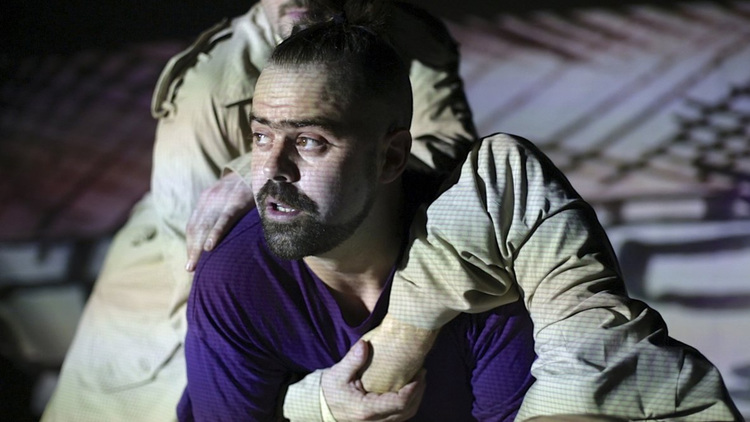“Put your hands in the air. Now put them down if you’ve never done anything you regret.”
As every hand in the room remains aloft, John Berkavitch is joined onstage by three men holding umbrellas.
“Don’t worry about them,” he says, “They’re just my imagination.”
So begins Shame, a show combining poetry, storytelling, movement, music and clever use of projection to create something truly unique. The tagline of the show is “What is the worst thing you’ve ever done?”, and in seventy minutes Berkavitch relates five different events, from his early childhood to his mid-twenties.
The narrative is complex without being convoluted, with the five different plots being interwoven in a non-linear fashion. Although incredibly raw and personal throughout, it still manages to be full of John’s characteristic wit, and these five stories are all curiously uplifting. His words feel meticulously crafted, shifting in and out of different rhymes and rhythms with seeming effortlessness, creating intensely vivid imagery and a feeling of movement - and that’s before the dancers have even started doing their thing.
Shame is a technical marvel. Berkavitch is joined by three pioneering break dancers, who provide a dynamism to the stories as well as acting as John’s stage props. I don’t want to spoil too much - however, one particularly stand-out moment was the three together playing the part of a coffee machine. This had John treating the front row like the queue in the coffee shop he was working in, asking for drinks orders and chatting about Christmas shopping. I’m not normally a massive fan of audience participation, but this was done so fluidly, and tied in so well to the plot, that it was nearly impossible not to buy into it. Suffice to say, I have never been so grateful to be handed an invisible toastie that’s just been pulled out of someone’s bum. Honestly.
Not content to let these three do all the hard work, Berkavitch is just as involved with the movements; frequently diving between and over limbs, being lifted and carried, being restrained by the others and many more besides. The result is stunning - as the movement is all in relation to the story being told, it never feels disjointed or detracts from John’s words.
The stage itself is minimalistic - a white floor and a white backdrop. It’s the addition of several projectors - at least five, I think - that allow images to be placed on the floor, the wall and even on the bodies of the actors. This is used in some incredibly inventive ways, while, again, never feeling out of place or providing unnecessary distraction. I was surprised (and amazed) to see that the lighting and music are all controlled from a laptop off to the side. This is started at the beginning of the show and then never again touched - the whole seventy minutes are choreographed with military precision. The sheer amount of practice that must have gone into this production is staggering.
The show ends with John asking the audience if anyone has a story they’d like to share. This feels rather sudden - though I suppose we should have expected it, especially given something similar was mentioned at the beginning. Unfortunately nobody did, though I’d be interested to know if this is the norm or if we were just a particularly shy crowd.
Shame pulls together elements from across the artistic spectrum into one incredibly polished production, which is an achievement in itself. However, it’s the inventiveness of the movement and animation, the unwavering attention to detail and, of course, John Berkavitch’s incredible talent for storytelling that really make it stand out. I fully intend to go and see it again - you should come too.
I saw Shame at the Roundhouse in Camden. It’s nearing the end of its current tour - there’s more information on John Berkavitch’s website.

